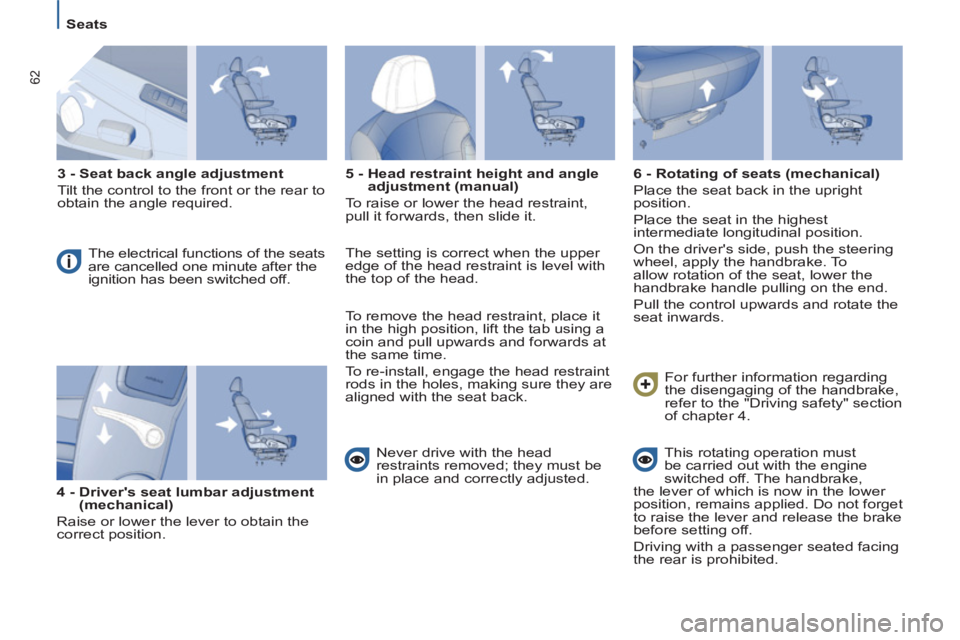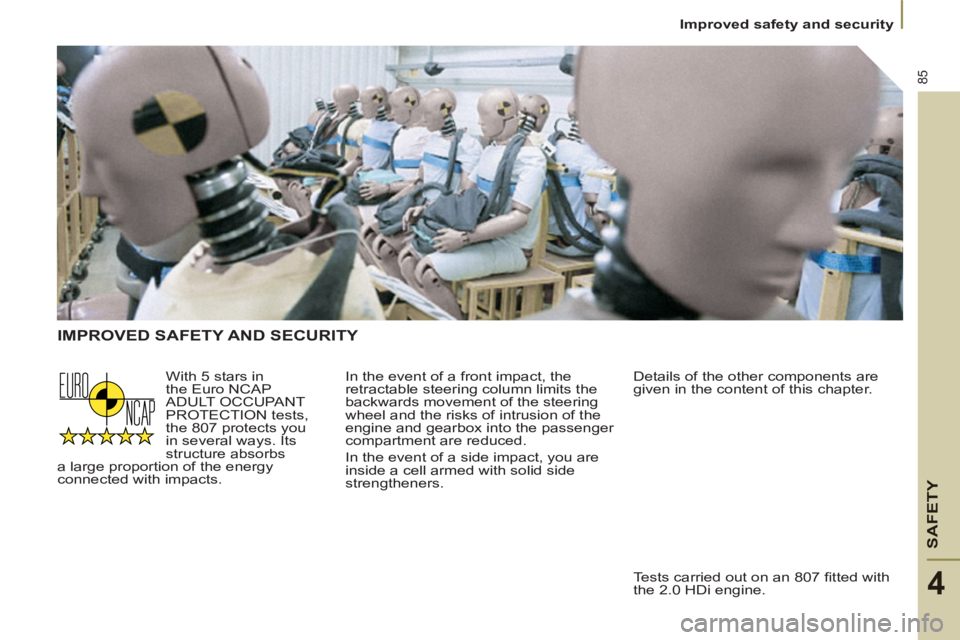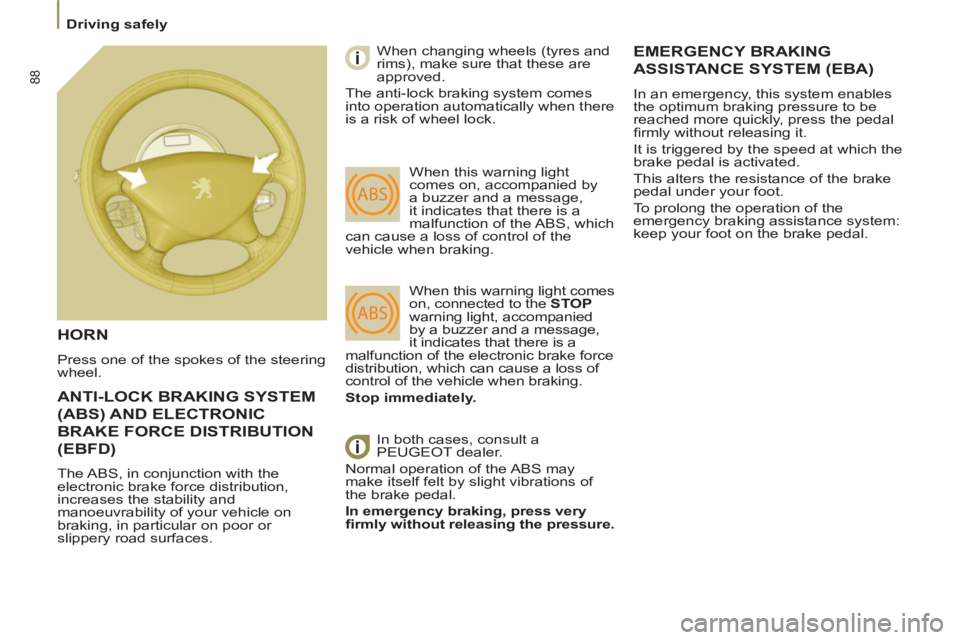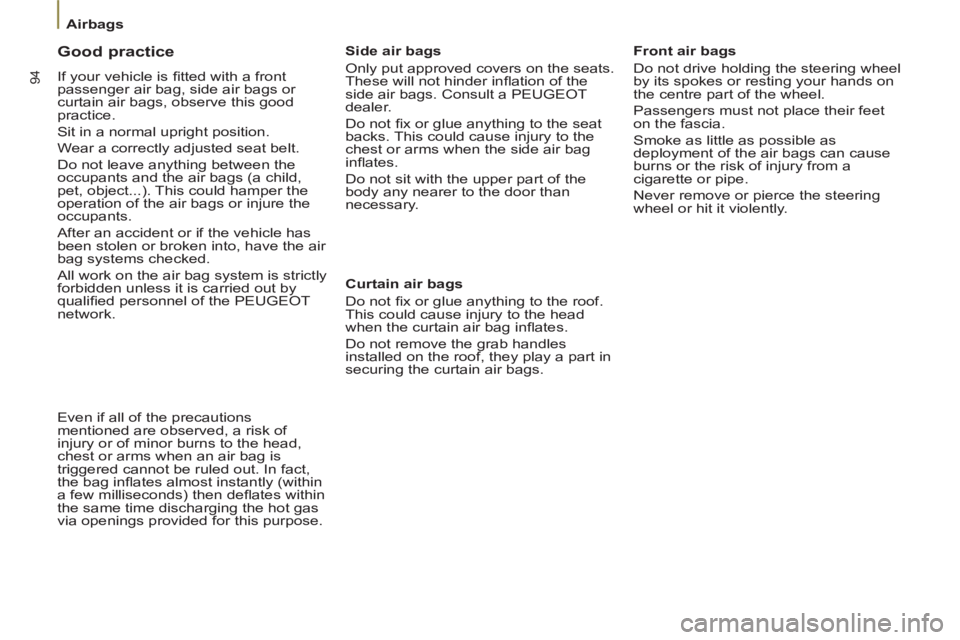2013 Peugeot 807 steering wheel
[x] Cancel search: steering wheelPage 64 of 234

62
Seats
3 - Seat back angle adjustment
Tilt the control to the front or the rear to
obtain the angle required.
The electrical functions of the seats
are cancelled one minute after the
ignition has been switched off.
4 - Driver's seat lumbar adjustment
(mechanical)
Raise or lower the lever to obtain the
correct position.
5 - Head restraint height and angle
adjustment (manual)
To raise or lower the head restraint,
pull it forwards, then slide it.
Never drive with the head
restraints removed; they must be
in place and correctly adjusted.
6 - Rotating of seats (mechanical)
Place the seat back in the upright
position.
Place the seat in the highest
intermediate longitudinal position.
On the driver's side, push the steering
wheel, apply the handbrake. To
allow rotation of the seat, lower the
handbrake handle pulling on the end.
Pull the control upwards and rotate the
seat inwards.
This rotating operation must
be carried out with the engine
switched off. The handbrake,
the lever of which is now in the lower
position, remains applied. Do not forget
to raise the lever and release the brake
before setting off.
Driving with a passenger seated facing
the rear is prohibited. For further information regarding
the disengaging of the handbrake,
refer to the "Driving safety" section
of chapter 4. The setting is correct when the upper
edge of the head restraint is level with
the top of the head.
To remove the head restraint, place it
in the high position, lift the tab using a
coin and pull upwards and forwards at
the same time.
To re-install, engage the head restraint
rods in the holes, making sure they are
aligned with the seat back.
Page 87 of 234

SAFETY
85
Improved safety and security
4
IMPROVED SAFETY AND SECURITY
In the event of a front impact, the
retractable steering column limits the
backwards movement of the steering
wheel and the risks of intrusion of the
engine and gearbox into the passenger
compartment are reduced.
In the event of a side impact, you are
inside a cell armed with solid side
strengtheners. With 5 stars in
the Euro NCAP
ADULT OCCUPANT
PROTECTION tests,
the 807 protects you
in several ways. Its
structure absorbs
a large proportion of the energy
connected with impacts.
Tests carried out on an 807 fi tted with
the 2.0 HDi engine.
Details of the other components are
given in the content of this chapter.
Page 90 of 234

88
Driving safely
ANTI-LOCK BRAKING SYSTEM
(ABS) AND ELECTRONIC
BRAKE FORCE DISTRIBUTION
(EBFD)
The ABS, in conjunction with the
electronic brake force distribution,
increases the stability and
manoeuvrability of your vehicle on
braking, in particular on poor or
slippery road surfaces.
HORN
Press one of the spokes of the steering
wheel. When changing wheels (tyres and
rims), make sure that these are
approved.
The anti-lock braking system comes
into operation automatically when there
is a risk of wheel lock.
When this warning light
comes on, accompanied by
a buzzer and a message,
it indicates that there is a
malfunction of the ABS, which
can cause a loss of control of the
vehicle when braking.
When this warning light comes
on, connected to the STOP
warning light, accompanied
by a buzzer and a message,
it indicates that there is a
malfunction of the electronic brake force
distribution, which can cause a loss of
control of the vehicle when braking.
Stop immediately.
In both cases, consult a
PEUGEOT dealer.
Normal operation of the ABS may
make itself felt by slight vibrations of
the brake pedal.
In emergency braking, press very
fi rmly without releasing the pressure.
EMERGENCY BRAKING
ASSISTANCE SYSTEM
(EBA)
In an emergency, this system enables
the optimum braking pressure to be
reached more quickly, press the pedal
fi rmly without releasing it.
It is triggered by the speed at which the
brake pedal is activated.
This alters the resistance of the brake
pedal under your foot.
To prolong the operation of the
emergency braking assistance system:
keep your foot on the brake pedal.
Page 91 of 234

SAFETY
89
Driving safely
4
TRACTION CONTROL (ASR)
AND DYNAMIC STABILITY
CONTROL
(ESP)
Activation of the ASR and ESP
systems
When the ignition is on, the ASR and
ESP systems are always active.
Disarming the ASR/ESP
systems
In certain conditions (vehicle stuck in
mud or snow, or on loose ground...), it
could prove useful to disarm the ASR
and ESP systems to make the wheels
spin and regain grip.
�)
Press the switch, situated under
the steering wheel on the left of the
fascia.
The indicator light comes on
accompanied by a message:
the ESP and ASR systems
no longer act on the engine
operation, but continue to act
on the brakes.
Operating check
The ASR/ESP systems offer
increased safety during normal
driving, but should not incite the
driver to take risks or to drive at high
speed.
The operation of these systems is
ensured if the recommendations
of the manufacturer regarding
the wheels (tyres and rims), the
braking components, the electronic
components and the fi tting and repair
procedures within the PEUGEOT
network are observed.
After an impact, have these systems
checked by a PEUGEOT dealer.
They engage again:
�)
automatically above 30 mph
(50 km/h),
�)
manually by pressing the switch
again.
Operation of the ASR and
ESP systems
The warning light fl ashes if
the ASR or ESP is activated.
These systems are linked and
complement the ABS.
The ASR system optimises drive to
prevent the wheels skidding, by acting
on the brakes of the drive wheels
and on the engine. It also allows the
directional stability of the vehicle to be
improved on acceleration.
If there is a variation between the
trajectory followed by the vehicle and
that required by the driver, the ESP
system automatically acts on the
engine and the brake of one or more
wheels, in order to put the vehicle back
on course, within the limits of the laws
of physics. When a malfunction of the
systems occurs, the indicator
light comes on, accompanied
by an audible signal and a
message on the display.
Consult a PEUGEOT dealer to have
the system checked.
Page 92 of 234

90
Driving safely
TYRE UNDER-INFLATION
DETECTION
Sensors check the tyre pressure during
driving, and trigger a warning in the
event of a malfunction (speed greater
than approx.15 mph [25 km/h]) or
puncture.
An outline representing one or more
wheels fl ashing indicates the location
of the wheel or wheels concerned.
Flat tyre
The SERVICE warning light
comes on, accompanied
by the message "Tyre(s)
defl ated"
, an outline on the display,
and an audible signal.
Check the tyre pressure as soon as
possible. If the damaged tyre is temporarily
stored in the boot, it will again emit
this message to remind you of the
necessity of having it repaired. This will
prevent another warning of the same
type being displayed.
Sensor(s) not detected
The SERVICE warning light
comes on, accompanied
by the message "X tyre
pressure sensor(s) missing"
, an
outline on the display and an audible
signal.
Under-infl ation detection is absent
from one (or several) tyre(s). Consult a
PEUGEOT dealer to replace the faulty
sensor(s). This message is also displayed
when one of the tyres is away
from the vehicle (being repaired)
or when a wheel without a sensor is
fi tted.
All repairs and changing of
tyres on a wheel fi tted with this
system must be carried out by a
PEUGEOT dealer.
The tyre under-infl ation detection
system is a driving aid which does
not take the place of the vigilance or
the responsibility of the driver.
This system does not remove the
need to have the tyre pressure
checked regularly (including the spare
wheel), to ensure that the dynamic
performance of the vehicle remains at
its best and to avoid premature wear
of the tyres, in particular in the case
of arduous driving (heavy load, high
speed).
The system may temporarily be
disturbed by radio broadcasts on a
frequency close to it.
Puncture
The STOP warning light
comes on, accompanied
by the message
"Punctured tyre(s)"
, an outline on the
display and an audible signal.
Stop immediately, avoiding any sudden
movement of the steering wheel and
the brakes.
Change the damaged (punctured or
very defl ated) tyre, and have the tyre
pressure checked as soon as possible.
Refer to the "Changing a wheel"
section of chapter 7.
Page 96 of 234

94
Airbags
Good practice
If your vehicle is fi tted with a front
passenger air bag, side air bags or
curtain air bags, observe this good
practice.
Sit in a normal upright position.
Wear a correctly adjusted seat belt.
Do not leave anything between the
occupants and the air bags (a child,
pet, object...). This could hamper the
operation of the air bags or injure the
occupants.
After an accident or if the vehicle has
been stolen or broken into, have the air
bag systems checked.
All work on the air bag system is strictly
forbidden unless it is carried out by
qualifi ed personnel of the PEUGEOT
network.
Front air bags
Do not drive holding the steering wheel
by its spokes or resting your hands on
the centre part of the wheel.
Passengers must not place their feet
on the fascia.
Smoke as little as possible as
deployment of the air bags can cause
burns or the risk of injury from a
cigarette or pipe.
Never remove or pierce the steering
wheel or hit it violently.
Side air bags
Only put approved covers on the seats.
These will not hinder infl ation of the
side air bags. Consult a PEUGEOT
dealer.
Do not fi x or glue anything to the seat
backs. This could cause injury to the
chest or arms when the side air bag
infl ates.
Do not sit with the upper part of the
body any nearer to the door than
necessary.
Curtain air bags
Do not fi x or glue anything to the roof.
This could cause injury to the head
when the curtain air bag infl ates.
Do not remove the grab handles
installed on the roof, they play a part in
securing the curtain air bags.
Even if all of the precautions
mentioned are observed, a risk of
injury or of minor burns to the head,
chest or arms when an air bag is
triggered cannot be ruled out. In fact,
the bag infl ates almost instantly (within
a few milliseconds) then defl ates within
the same time discharging the hot gas
via openings provided for this purpose.
Page 98 of 234

96
Airbags
Disarming
The passenger's front air bag alone
can be disarmed:
- With
the
ignition
switched
off
,
insert the key into the passenger air
bag disarming switch,
- turn it to the "OFF"
position,
-
then remove the key keeping the
slot in this position.
Front air bags
The front air bags are incorporated in
the centre of the steering wheel for the
driver and in the fascia for the front
passenger.
Front air bag fault
Reactivation
In the "OFF"
position, the passenger
air bag will not be triggered in the
event of an impact.
As soon as the child seat is removed,
turn the air bag slot to the "ON"
position to re-activate the air bag
and thus ensure the safety of your
passenger in the event of an impact. To ensure the safety of your
child, it is essential to disarm the
passenger air bag when you install
a rear-facing child seat on the front
passenger seat. Otherwise, the child
would risk being killed or seriously
injured if the air bag were to infl ate.
The air bag warning light
on the instrument panel is
lit throughout the period of
disarming.
If the two air bag warning lights
are lit continuously, do not install
a rear-facing child seat. Consult a
PEUGEOT dealer.
Activation
They are deployed simultaneously,
unless the passenger's front air bag
has been disarmed, in the event of a
serious front impact applied to all or
part of the front impact zone A
in the
longitudinal centreline of the vehicle
on a horizontal plane directed from the
front towards the rear of the vehicle.
The front air bag infl ates between
the front occupant of the vehicle and
the fascia to cushion his forward
movement. If this warning light comes on,
accompanied by an audible
signal and a message on the
display, consult a PEUGEOT
dealer to have the system
checked.
Page 106 of 234

104
Towing a trailer
On the contrary, use a high gear to
lower the engine speed and reduce
your speed.
In all cases, pay attention to the
coolant temperature.
Brakes:
towing increases the braking
distance. Drive at a moderate speed,
change down early and brake
gradually. Please contact a PEUGEOT dealer
fi rst for further information.
Automatic adjustment
For vehicles with Xenon bulbs, and if
the change in load makes it necessary,
this system automatically corrects the
height of the beam after approximately
2 minutes. The driver is then assured
of having optimum lighting and not
causing a nuisance to other road
users.
In certain cases of particularly
arduous use (towing the
maximum load up a steep slope
in high temperatures), the engine
automatically limits its power. In this
case, cutting off the air conditioning
allows the engine power to be
recovered, and therefore the towing
speed to be signifi cantly increased
(approximately 12 mph [20 km/h]
more). Sequential control of the
gearbox may also become unavailable.
Lighting
Bicycle carrier
Refer to the "Identifi cation
features" section of chapter 8. Refer to the "Steering wheel
controls" section of chapter 3.
When using a trailer connection,
you must add a fuse. Refer to
the "Changing a fuse" section of
chapter 7.
If the coolant temperature warning light
comes on, stop the vehicle and switch
off the engine as soon as possible.
Tyres:
check the tyre pressures of
the towing vehicle and of the trailer,
observing the recommended pressure.
Side wind:
sensitivity to side wind is
increased. Drive smoothly and at a
moderate speed.
Towbar
We recommend the use of original
PEUGEOT towbars, which have been
tested for endurance from the design
stage of your vehicle.
Towing equipment must be fi tted in
accordance with the manufacturer's
instructions, with particular attention to
the towing capacities of your vehicle,
the load towed, the nose weight and
the electrical connection. As this fi tting
should be carried out by a professional,
we recommend that you entrust the
fi tting of this equipment to a PEUGEOT
dealer.
In accordance with the general
instructions referred to above, we draw
your attention to the risk connected
with fi tting a towbar or other electrical
accessory which is not recommended
by the PEUGEOT network. Fitting such
equipment could result in a failure of
your vehicle's electronic system.
Manual adjustment
Adjust your headlamps so as not to
dazzle other road users. Check the
electrical signalling of the trailer.
If you fi t a bicycle carrier on
the tailgate, deactivate the
rear wiper from the display's
confi guration menu.